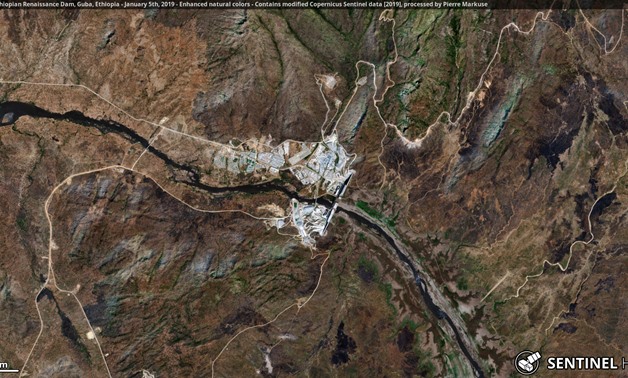
Grand Ethiopian Renaissance Dam, Guba, Ethiopia- CC via Flickr/Pierre Markuse
CAIRO - 31 January 2020: The US, WB-brockerd negotiations between Egypt, Sudan and Ethiopia over the controversial Grand Ethiopian Renaissance Dam (GERD) resumed in Washington D.C. for the third day in a row, said Egyptian Foreign Ministry spokesperson Ahmed Hafez on Thursday evening.
“Washington negotiations on Renaissance Dam are still ongoing ... The Ministers of Foreign Affairs and Water Resources participate in the meetings that convene upon an invitation from the American Administration for Egypt, Ethiopia and Sudan in the presence of the World Bank, to a comprehensive agreement on the rules for filling and operating Renaissance Dam,” Hafez siad in a Twitter post.
The Ministers of Foreign Affairs and Water Resources of Egypt, Sudan and Ethiopia are holding a series of meetings, in presence of representatives from the US Department of Treasury and the World Bank, to reach a final agreement on the disputed points regarding the GERD construction, after the three countries failed to reach an agreement on operating the dam and filling its reservoir with Nile Water early January 2020.
However, the three countries were invited to resume the negotiations in Washington on January 13-15, 2020 when they finally achieved a breakthrough and agreed on an agreement concerning the technical and scientific problems on the dam construction, saying that January 28-29 meetings aim to “finalize a comprehensive agreement” on the dam.
The points that are subjected to the final agreement are the following as per a statement from the US treasury:
The filling of the GERD will be executed in stages and will be undertaken in an adaptive and cooperative manner that takes into consideration the hydrological conditions of the Blue Nile and the potential impact of the filling on downstream reservoirs.
Filling will take place during the wet season, generally from July to August, and will continue in September subject to certain conditions.
The initial filling stage of the GERD will provide for the rapid achievement of a level of 595 meters above sea level (m.a.s.l.) and the early generation of electricity, while providing appropriate mitigation measures for Egypt and Sudan in case of severe droughts during this stage.
The subsequent stages of filling will be done according to a mechanism to be agreed that determines release based upon the hydrological conditions of the Blue Nile and the level of the GERD that addresses the filling goals of Ethiopia and provides electricity generation and appropriate mitigation measures for Egypt and Sudan during prolonged periods of dry years, drought and prolonged drought.
During long term operation, the GERD will operate according to a mechanism that determines release based upon the hydrological conditions of the Blue Nile and the level of the GERD that provides electricity generation and appropriate mitigation measures for Egypt and Sudan during prolonged periods of dry years, drought and prolonged drought.
An effective coordination mechanism and provisions for the settlement of disputes will be established.
The disagreement between the three states dates back to May 2011 when Ethiopia started building the dam; Cairo has voiced its concerns that building the dam could harm its 55.5 billion cubic meters share as 80 percent of Egypt’s share comes from the Blue Nile and Ethiopian Heights, while Ethiopia says it is necessary for its development and electricity production. However, the three countries reached an initial deal, announcing the “Declaration of Principle,” per which the dam should cause any harm to the Nile downstream countries.

Comments
Leave a Comment